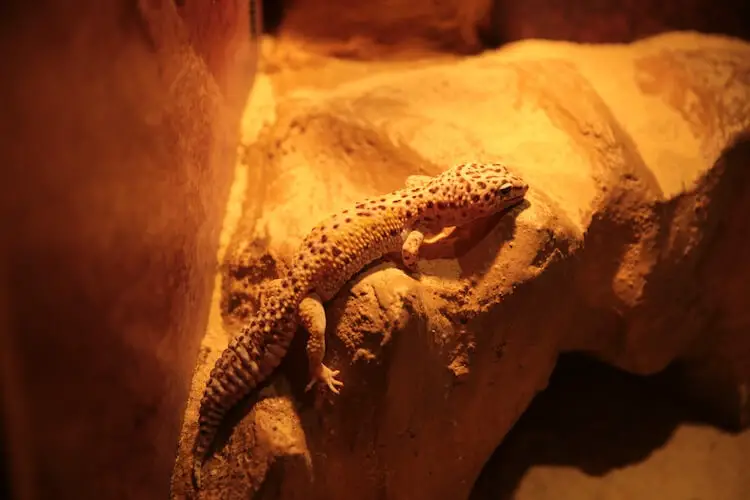
Leopard geckos are from the dry deserts and grasslands of India and the Middle East. These hardy lizards make excellent pets and are very easy to keep.
But, lighting is one care aspect that is often overlooked.
It may not seem important, but proper leopard gecko lighting is critical to their health.
For new owners, finding the perfect lighting setup can be difficult. This job is also made harder because of myths like leopard geckos do not need lighting during the day because they are nocturnal. This is not true!
Luckily, with a few tips, you will find that lighting and heating your gecko’s enclosure is not as hard as it first seems. Read on for a detailed guide to the best lighting setup, schedule and heat lamp options.
Leopard Gecko Lighting
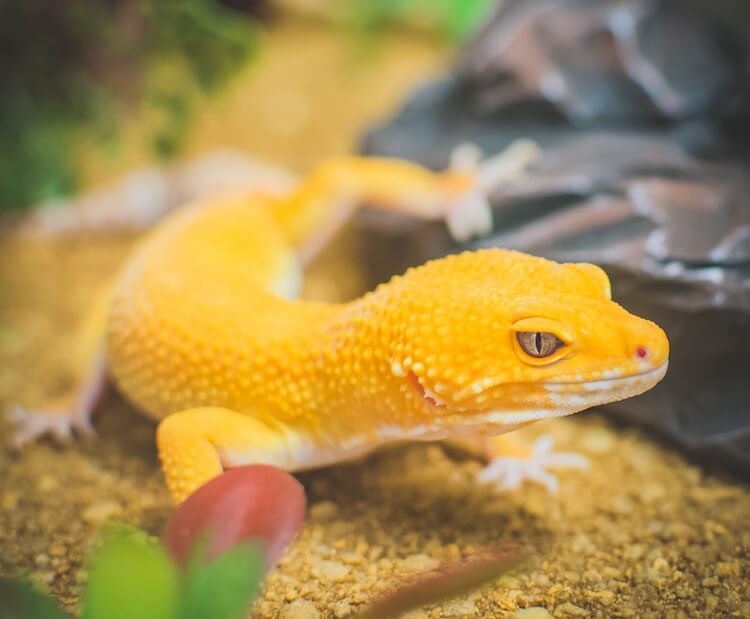
Despite leopard geckos being one of the most popular pet reptiles in the world, there are still plenty of myths and misconceptions about their lighting requirements.
The perfect lighting setup for a leopard gecko is fairly simple and can be done in two different ways.
Leopard geckos need both lighting and heat during the day and only heat at night. This can be achieved with a mix-and-match combination of several different lighting and heating elements.
Option 1: Heat Lamp with Night Heat Source
The first option is to use a light and heat lamp combination bulb. These bulbs are often called daylight or basking bulbs. They are used to provide both heat and light during the daytime. At night, when the daylight bulb is off, a secondary heat source needs to be used to keep the tank warm. The most popular heat bulb is a ceramic bulb. However, you can also use a heat mat.
Both the basking and ceramic bulb should be connected to a thermostat to control the temperatures. Thermostats maintain temperatures in the enclosure and prevent overheating by shutting off any malfunctioning elements. It is also a good idea to connect your heat lamp to an automatic timer. This means you do not have to remember to switch these elements on and off each day.
Option 2: UVB Light with 24-Hour Heat Source
The second option is to use a light-only bulb. These bulbs are often called full-spectrum or UV bulbs and are used to provide daylight. However, unlike the basking bulb, light-only bulbs do not put off any heat.
So, with option two, you will also need a separate heat source. The heat source provides warmth during the day and night, while the light stays on only during the day. Some owners prefer this option because only the light needs to be switched off and on; the heat source stays on constantly.
Option two is used by many keepers because there are more UV options available as light-only bulbs.
Before we go into the specific setup of each option, we will share some of the most common myths about lighting for leopard geckos to help you avoid these mistakes.
Myths and Mistakes
Leopard Geckos Are Nocturnal
Leopard geckos are active at night and prefer to sleep during the day, but this does not make them nocturnal. Nocturnal animals are only active after the sun is completely set.
Geckos are most active around dawn and dusk, when the sun is just setting and rising. They will remain busy into the night, but they prefer to start their day when there is still some daylight. Because of this, they are actually crepuscular.
Leopard Geckos Do Not Need Daytime Lighting
Leopard geckos are crepuscular and need a daylight cycle to regulate their bodies’ circadian rhythms, sleep cycle and wakefulness. It is just as important to provide them with a regular period of light during the day as it is to provide a period of darkness at night. Leopard geckos use the daytime to sleep, digest food, and bask. They are most active at dusk and through the night.
Leopard Geckos Do Not Need UVB
Many keepers assume Leopard Geckos do not require a UVB light because they rarely come out during the day. However, Geckos who are exposed to UVB, even for just two hours a day, have higher blood levels of vitamin D. This reduces their risk of metabolic bone disease and fractures. So, while they may not need UVB to survive, it is proven to benefit them and should always be provided.
Natural Light
Light from your window may look nice, especially during summer, but just a few hours of direct sunlight can easily cause your gecko’s tank to overheat. Also, most of the beneficial UV rays from sunlight are blocked by windows. This means reptiles exposed to sunlight from a window can still develop metabolic disorders.
It is best to avoid using natural light, especially direct sunlight, as a source of lighting or heating for your leopard gecko’s habitat.
Lighting for Leopard Geckos
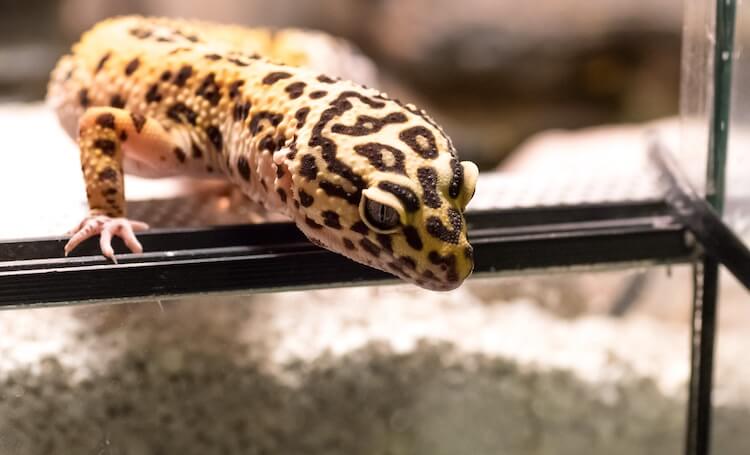
Leopard gecko lighting at night should be different from lighting in the day.
Geckos only need heat at night, but during the day they need both lighting and heat. This can be achieved with a mix-and-match combination of several different lighting and heat lamp combinations.
Some of the most popular lighting and heating options include:
- Light and Heat Day Bulbs: Also known as “daytime bulbs” or “heat lamps”, these bulbs emit both light and heat. They range in wattage from 15 to 150, but 100 to 150 watts is best for leopard geckos. If you can, try and find a bulb that does not put out too much UV radiation. The only downside of this bulb is that it must be turned off at night, resulting in the need for a new heat source after dark.
- Light Only Bulbs: Light only bulbs are great for daytime viewing and can be turned off at night without losing a heat source. This type of light includes regular incandescent, fluorescent, and UV bulbs. Look for bulbs that are 10.0 UVB or less. Just as too little UVB is harmful, too much can damage your gecko’s sensitive eyes and thin skin. Screen tops filter out a lot of UV, so not all of the 10% UV will reach your gecko. If combined with a heating element like a ceramic heat bulb or under-tank heater, these bulbs work great too.
- Ceramic Heat Bulbs: Ceramic bulbs put out a lot of heat but no light. They are the ideal complement to a light only bulb. Ceramic bulbs have a long five year lifespan and can raise the ambient air temperature of an enclosure by up to 20°F. The wattage you need will range from 100 to 150 depending on your enclosure size.
- Heat Mat or Tape: Heat mats are a nighttime heat source. They can be stuck on the bottom or sides of a glass enclosure and are an alternative to ceramic heat bulbs. They are normally low wattage and do not get as hot as ceramic bulbs.
Daytime Lighting
For a day light you can either use a:
- Light only bulb (combined with a heat source)
- Light and heat day bulb (i.e. basking bulb / heat lamp)
- Ambient room lighting (though not direct sunlight and combined with a heat source)
It was assumed for a long time that leopard geckos did not need UVB because they are not active during bright daylight hours. Many pet geckos kept without UVB have lived long, healthy lives.
However, recent studies are now suggesting that leopard geckos do use UVB when it is available.
While this still remains a hotly debated topic, we recommend providing a 10.0 UV bulb. 10% UV is the upper limit for Leopard Geckos. Higher percentages can damage their thin skin. 5% UV is also available and is well suited for Leopard Geckos.
Generally, 5 to 6% UVB lights are perfect for leopard geckos. It is best to get a made-for-reptiles UV light as they are designed to output controlled amounts of light and UV radiation.
Most UV bulbs are fluorescents, though mercury vapor bulbs also emit UVB. Despite emitting light for two or three years, these bulbs should be changed every six months as their UVB output is diminished after that.
Be careful with mercury bulbs as they put out a lot of heat. You should be careful to monitor the temperatures of your tank if you choose to use one. Overall, mercury bulbs are better for larger reptiles that need warmer temperatures than Geckos.
Full spectrum lights generally only refer to the spectrum of visible light and are low in UVB. Incandescent bulbs do not emit any UV radiation.
After deciding on the light you want to use, there are two kinds of light fixtures you will need to consider; dome lights and strip lights.
Dome light fixtures can house an array of lights, from ceramic heat bulbs to basking bulbs and UVB. This style of fixture concentrates light on a specific area. They are more useful for UVB and heat spots, rather than visible light.
Strip light fixtures are best for full spectrum lights because they light up a larger area of the enclosure. But, they can also be used for UV and incandescent bulbs.
Leopard Gecko Lighting at Night
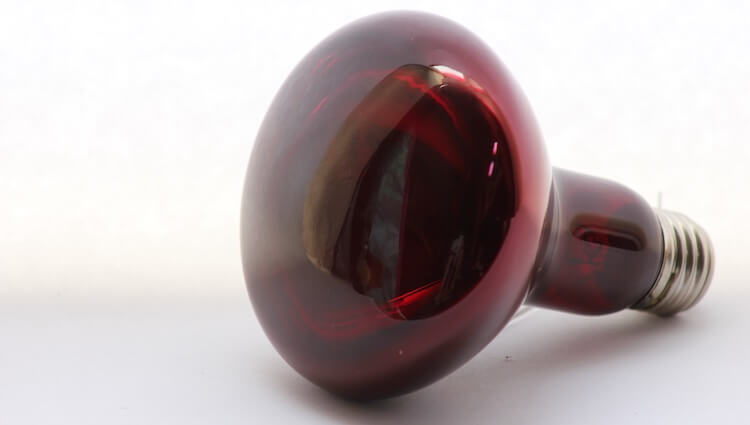
Leopard geckos have excellent night vision and do not need any light at night. However, because they are more active, some owners may want to watch their geckos at night. In that case, red or blue lights the best possible options.
These lights can be kept on for two hours after you switch off the day light, but they should not be used all night. Full darkness is important for health of these night-loving lizards.
Below we look at the pros and cons of each light:
- Blue Lights: They give off a blue glow, similar to moonlight, that provides enough light for humans to watch their gecko at night. Unfortunately, while these bulbs are dark, Leopard Geckos can still see the light it gives off. This can interrupt their sleep cycle if used for more than two hours.
- Red Lights: They give off a warm, red glow instead of a cool blue. The same problem stands for red lights as blue. A Gecko’s night vision makes the light seem much brighter to them than us.
- Black Lights: This light emits a purple glow via UV-A light. The long-term effects of this kind of light on any type of Gecko are not well-known. For this reason, they should not be used.
Heating at Night
Remember that despite not needing any lighting at night, leopard geckos still require a high temperature. This heat keeps them warm and maintains humidity.
Ceramic heat bulbs are the best option. They are normally less than $20 and last for five years or longer.
We recommend using porcelain sockets for them as they get hot enough to melt most plastics. When replacing a ceramic heat bulb, make sure it is unplugged and cool enough to touch. They hurt!
Under-tank heaters can be used too, but they are the most expensive heat source and are not as reliable. Expect to pay around $30 for a 25-gallon heater with a lifespan of only two years; compared to five years for ceramic heat bulbs.
Under-tank heaters raise the surface temperature of your Leopard Gecko’s enclosure. They will not significantly raise the air temperature. Ceramic heat bulbs will do the opposite. Because of this, using a temperature probe to monitor overheating is very important.
A thermostat’s probe should be placed as close to the “hot side” basking spot as possible to measure the enclosure’s maximum temperature. As long as this temperature is within normal ranges, you do not need a temperature probe on the cool side.
Some keepers use both heating elements together to achieve a steady ambient and floor temperature on the warm side of the tank, but this is not necessary.
Leopard Gecko Heating
Leopard geckos need a consistent temperature range in their enclosure. This is known as a temperature gradient and helps them to properly regulate their body heat.
There should be a hot side and a cool side to their tank. There should also be a basking spot that remains at the high ranges of both day and night temperatures.
Geckos that can move between temperatures will choose their own basking temperature, grow faster and gain more weight when compared to those kept at a single temperature.
| Area | Temperature Range |
|---|---|
| Warm Side | Day: 89 to 94°F Night: 84 to 90°F |
| Cool side | Day: 75 to 80°F Night: 68 to 75°F |
| Basking spot (surface) | Day: 90 to 94°F Night: 87 to 90°F |
| Humid hide | Day: 86 to 90°F Night: 83 to 86°F |
It is important to measure the temperature inside your Leopard Gecko’s humid hide too. Low temperatures, combined with the hide’s high humidity, can lead to respiratory problems. For this reason, it is a good idea to use two thermometers:
- An infrared or probe thermometer for measuring surface temperature.
- A regular thermometer for air temperature.
Light Cycle and Schedule
In the wild Leopard Geckos may brumate and go into a period of dormancy. Brumation is very common in reptiles and happens during the winter. You can read our guide to bearded dragon brumation to learn more.
Pet and morph Leopard Geckos do not normally brumate. Because of this, the heating and lighting schedule only needs minimal adjustment for summer/winter cycles.
This adjustment should be made over a span of six weeks in the spring or fall.
A small adjustment of light (not temperature) is needed over the winter, when days in the leopard geckos’ natural habitats are shorter. You may also need to check tank temperature during the winter and increase the heat to make up for the generally cooler indoor climate.
See below for an example chart of summer and winter lighting and heating schedules:
| Lighting and Heating | 8:00am to 10:00pm | 10:00pm to 8:00am |
|---|---|---|
| UVB Light Ceramic bulb |
Light: on Heat source: on |
Light: off Heat source: on |
| Basking bulb Ceramic bulb |
Heat lamp: on Heat source: off |
Heat lamp: off Heat source: on |
| Lighting and Heating | 9:00am to 9:00pm | 9:00pm to 9:00am |
|---|---|---|
| UVB Light Ceramic bulb |
Light: on Heat source: on |
Light: off Heat source: on |
| Basking bulb Ceramic bulb |
Light: on Heat source: off |
Light: off Heat source: on |
Best Leopard Gecko Lighting Setup
Lighting for a leopard gecko ranges widely in price, durability and lifespan.
Prior to placing your gecko in its enclosure, you should have the lighting and heating setup. You should also be able to maintain heat and humidity in the tank.
The most important aspect of lighting is to use it to provide a heat gradient along the length of the tank. It also helps to regulate your lizard’s sleep cycle.
Use one side of the tank as the warm side. Put your heating elements (e.g. basking bulb and ceramic heat bulb) on that side. They should be placed directly above the tank, rather than on the side. This prevents bright lights from shining directly into your Leopard Gecko’s eyes.
Usually, the heating elements on the warm side generate enough heat to keep the cool side at the correct temperature. But, tanks larger than 25-gallons may need a low-power, secondary heat source.
The cool side of the tank should not have any heating elements. But, it can have lights if you are not using a UV basking bulb. You can use a fluorescent UV bulb or strip light that does not put off heat.
Finally, thermostats are important tool for any reptile owner.
Thermostats plug into a wall socket and have a temperature-reading probe that sits close to the heater on the warm side of the tank to measure the temperature.
Heaters are plugged into the thermostat, which automatically shuts them off if temperatures get above a set limit.
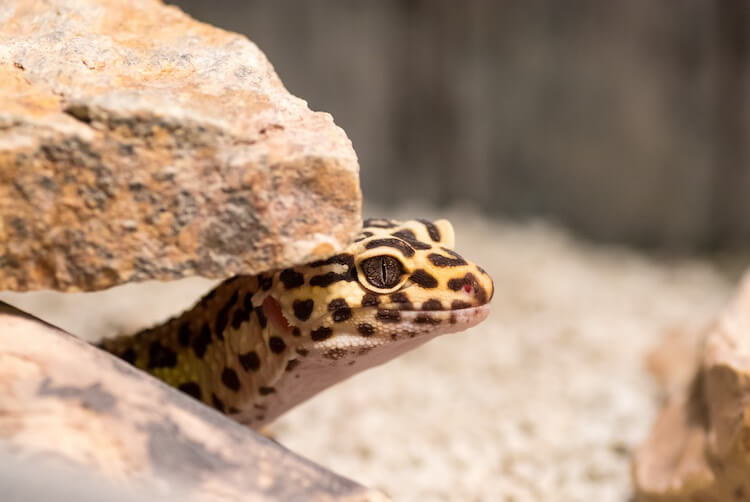
Summary
Contrary to some myths, daytime lighting is just as important to leopard geckos as nighttime darkness. Another common debunked myth is that they do not need UVB.
Lighting helps to keep your lizard’s internal clock correct, provides them with warmth, and simulates their natural behaviors.
Heating and lighting can be achieved through several combinations of lamps and heaters, but the best setup is a 5.0 UVB basking bulb a 100W Ceramic Heat Emitter.
Temperature and timing should also be regulated via a thermostat and automatic timer. This should only be adjusted twice each year for summer/winter cycles.
Have we shed some light on this important part of leopard gecko care?
Let us know in the comments.

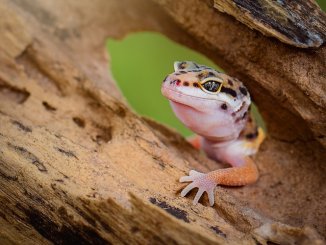
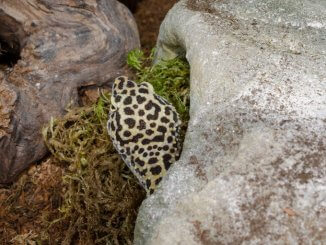
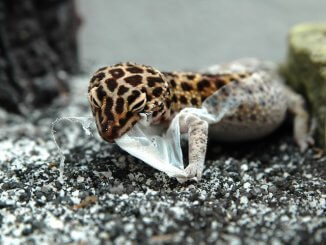

Is it possible for you to provide link(s) to specific proper lighting products?
Can you please advise on whether a leopard gecko should have a desert uvb bulb, or a tropical uvb bulb?
Thank you!
Hi Brandi! Tropical or desert UVB bulbs are mostly marketing strategies: the correct setup depends on your enclosure and the quality of the bulb. A leopard gecko is indeed from a rocky, arid habitat, which would suggest a desert bulb, but it is a crepuscolar species which rarely basks in the sun. For a correct UV setup, check charts like the Zoo Med UVB chart guide, which takes into consideration product, distance from the animal, and animal basking behavior.
I have a heat projector and a heat mat should i leave the projecter on at night and turn off the mat i never run them together ?
That mainly depends on the internal temperature of your enclosure. I would prioritize the heat projector which is a more natural and healthy heat source, resorting to the heat map only when the tank gets cold. At night temperatures need to drop (although never below 68° on the cooler side of the enclosure), reproducing the day and night temperature cycles that geckos would experience in their natural habitat. In other words, the answer to your question depends on what happens in your town, inside your house and inside the enclosure at night: you might need to turn everything off to reproduce a normal temperature cycle, or (in most cases) you might need to keep one heat source on. At night, a heat map better reproduces natural conditions, since it mimics the slow release of heat accumulated in the ground.